
Illustrative Math Alignment: Grade 7 Unit 7
Angles, Triangles, and Prisms
Lesson 13: Decomposing Bases for Area
Use the following Media4Math resources with this Illustrative Math lesson.
| Thumbnail Image | Title | Body | Curriculum Nodes |
|---|---|---|---|
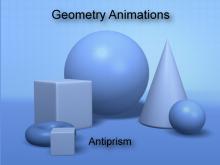
|
VIDEO: 3D Geometry Animation: Antiprism | VIDEO: 3D Geometry Animation: Antiprism
This is part of a series of video animations of three-dimensional figures. These animations show different views of these figures: top, side, and bottom. Many of these figures are a standard part of the geometry curriculum and being able to recognize them is important. — CLICK THE PREVIEW BUTTON TO SEE THE VIDEO ANIMATION —Study these animations to learn the basic properties of these 3D figures. In particular, make a note of their sides, edges, and vertices. Look for any symmetries they have. Look for polygon shapes that are familiar. Finally, think of real-world examples that use these figures. Below we also include information about Platonic solids and 2D nets of these 3D figures. To get a better understanding of these 3D figures, study these basic forms. |
3-Dimensional Figures and Triangular Prisms |

|
VIDEO: 3D Geometry Animation: Rectangular Prism | VIDEO: 3D Geometry Animation: Rectangular Prism
This is part of a series of video animations of three-dimensional figures. These animations show different views of these figures: top, side, and bottom. Many of these figures are a standard part of the geometry curriculum and being able to recognize them is important. — CLICK THE PREVIEW BUTTON TO SEE THE VIDEO ANIMATION —Study these animations to learn the basic properties of these 3D figures. In particular, make a note of their sides, edges, and vertices. Look for any symmetries they have. Look for polygon shapes that are familiar. Finally, think of real-world examples that use these figures. Below we also include information about Platonic solids and 2D nets of these 3D figures. To get a better understanding of these 3D figures, study these basic forms. |
3-Dimensional Figures and Rectangular Prisms |
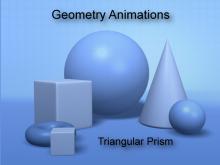
|
VIDEO: 3D Geometry Animation: Triangular Prism | VIDEO: 3D Geometry Animation: Triangular Prism
This is part of a series of video animations of three-dimensional figures. These animations show different views of these figures: top, side, and bottom. Many of these figures are a standard part of the geometry curriculum and being able to recognize them is important. — CLICK THE PREVIEW BUTTON TO SEE THE VIDEO ANIMATION —Study these animations to learn the basic properties of these 3D figures. In particular, make a note of their sides, edges, and vertices. Look for any symmetries they have. Look for polygon shapes that are familiar. Finally, think of real-world examples that use these figures. Below we also include information about Platonic solids and 2D nets of these 3D figures. To get a better understanding of these 3D figures, study these basic forms. |
3-Dimensional Figures |
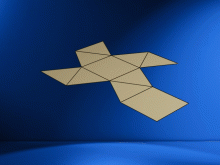
|
Animated Math Clip Art--3D Geometry--Net for Antiprism | Net for AntiprismTopic3D Geometry DescriptionThis animation shows the net of an antiprism unfolding and folding. A net is a 2D representation of a 3D shape that, when folded, creates the 3D object. For an antiprism, this includes two polygonal bases and a band of triangles. Animated math clip art like this is invaluable for teaching as it helps students visualize the transition between 2D and 3D representations. Teachers can use this to explain concepts of surface area, shape properties, and spatial reasoning. |
3-Dimensional Figures |

|
Animated Math Clip Art--3D Geometry--Net for Cube | Net for CubeTopic3D Geometry DescriptionThis animation demonstrates the net of a cube folding into the cube. A cube's net consists of six connected squares that, when folded, form the six faces of the cube. Using animated math clip art like this helps students understand the relationship between 2D and 3D shapes. Teachers can use this to discuss concepts such as surface area, volume, and spatial relationships. Here's a potential script for teachers: "Observe how this 2D net folds into a 3D cube. How many squares make up the net? How does this help us calculate the surface area of a cube?" |
3-Dimensional Figures |
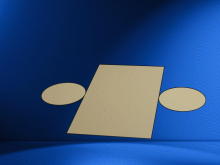
|
Animated Math Clip Art--3D Geometry--Net for Cylinder | Net for CylinderTopic3D Geometry DescriptionThis animation shows the net of a cylinder folding into the cylinder. A cylinder's net consists of a rectangle (which forms the lateral surface) and two circles (the bases). Animated math clip art like this is crucial for teaching as it helps students visualize how 2D shapes can form 3D objects. Teachers can use this to explain concepts of surface area, curved surfaces, and the properties of cylinders. Here's a potential script for teachers: "Watch how this 2D net folds into a 3D cylinder. Can you identify the parts that form the curved surface and the bases? How does this help us understand the surface area of a cylinder?" |
3-Dimensional Figures |
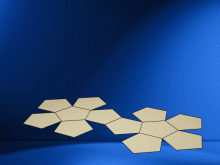
|
Animated Math Clip Art--3D Geometry--Net for Dodecahedron | Net for DodecahedronTopic3D Geometry DescriptionThis animation demonstrates the net of a dodecahedron folding into the dodecahedron. A dodecahedron's net consists of 12 connected pentagons that, when folded, form the 12 faces of the dodecahedron. Using animated math clip art like this helps students understand complex 3D shapes and their 2D representations. Teachers can use this to discuss properties of polyhedra, symmetry, and advanced geometric concepts. Here's a potential script for teachers: "Observe how this 2D net folds into a 3D dodecahedron. How many pentagons make up the net? How does this help us understand the structure and properties of a dodecahedron?" |
3-Dimensional Figures |
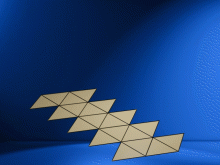
|
Animated Math Clip Art--3D Geometry--Net for Icosahedron | Net for IcosahedronTopic3D Geometry DescriptionThis animation shows the net of an icosahedron folding into the icosahedron. An icosahedron's net consists of 20 connected equilateral triangles that, when folded, form the 20 faces of the icosahedron. Animated math clip art like this is invaluable for teaching complex polyhedra. It helps students visualize how 2D shapes can form intricate 3D objects. Teachers can use this to explain concepts of symmetry, polyhedra properties, and advanced geometric relationships. |
3-Dimensional Figures |
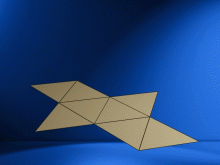
|
Animated Math Clip Art--3D Geometry--Net for Octahedron | Net for OctahedronTopic3D Geometry DescriptionThis animation demonstrates the net of an octahedron folding into the octahedron. An octahedron's net consists of 8 connected equilateral triangles that, when folded, form the 8 faces of the octahedron. Using animated math clip art like this helps students understand the relationship between 2D and 3D representations of polyhedra. Teachers can use this to discuss concepts such as symmetry, face relationships, and properties of regular polyhedra. Here's a potential script for teachers: "Observe how this 2D net folds into a 3D octahedron. How many triangles make up the net? How does this help us understand the structure and symmetry of an octahedron?" |
3-Dimensional Figures |
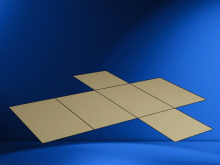
|
Animated Math Clip Art--3D Geometry--Net for Rectangular Prism | Net for Rectangular PrismTopic3D Geometry DescriptionThis animation shows the net of a rectangular prism folding into the rectangular prism. A rectangular prism's net consists of six rectangles: two identical pairs of congruent rectangles for the sides, and another pair for the top and bottom. Animated math clip art like this is crucial for teaching as it helps students visualize how 2D shapes form 3D objects. Teachers can use this to explain concepts of surface area, volume, and the properties of prisms. |
3-Dimensional Figures |
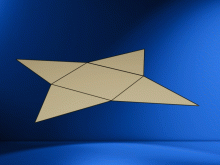
|
Animated Math Clip Art--3D Geometry--Net for Square Pyramid | Net for Square PyramidTopic3D Geometry DescriptionThis animation demonstrates the net of a square pyramid folding into the square pyramid. A square pyramid's net consists of a square base and four triangular faces that meet at the apex. Using animated math clip art like this helps students understand the structure of pyramids and how 2D shapes form 3D objects. Teachers can use this to discuss concepts such as surface area, slant height, and the properties of pyramids. |
3-Dimensional Figures |
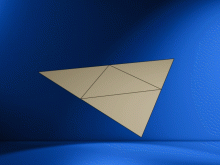
|
Animated Math Clip Art--3D Geometry--Net for Tetrahedron | Net for TetrahedronTopic3D Geometry DescriptionThis animation shows the net of a tetrahedron folding into the tetrahedron. A tetrahedron's net consists of four equilateral triangles that, when folded, form the four faces of the tetrahedron. Animated math clip art like this is invaluable for teaching as it helps students visualize how 2D shapes form 3D objects. Teachers can use this to explain concepts of symmetry, face relationships, and properties of regular polyhedra. Here's a potential script for teachers: "Watch how this 2D net folds into a 3D tetrahedron. How many triangles make up the net? How does this help us understand the structure and symmetry of a tetrahedron?" |
3-Dimensional Figures |
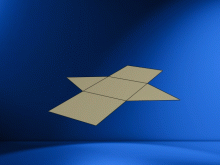
|
Animated Math Clip Art--3D Geometry--Net for Triangular Prism | Net for Triangular PrismTopic3D Geometry DescriptionThis animation shows the net of a triangular prism folding into the triangular prism. A triangular prism's net consists of two triangular bases and three rectangular faces that form the lateral surface. Animated math clip art like this is crucial for teaching as it helps students visualize how 2D shapes form 3D objects. Teachers can use this to explain concepts of surface area, volume, and the properties of prisms. |
3-Dimensional Figures |

|
Closed Captioned Video: Geometry Applications--Antiprisms | Closed Captioned Video: Geometry Applications--Antiprisms
In this video students learn the basics of antiprisms, in the context of New York’s Freedom Tower, which has an antiprism design. They learn the properties of antiprisms, with the focus on those with a square base. |
Rectangular Prisms |

|
Closed Captioned Video: Geometry Applications--Rectangular Prisms | Closed Captioned Video: Geometry Applications--Rectangular Prisms
In this video students learn the basics of rectangular prisms, in the context of a New York residential tower: 432 Park Avenue. They learn the properties of rectangular prisms, with and without square bases, and the architectural requirements that influence the use of both types of rectangular prisms. |
Rectangular Prisms |

|
Closed Captioned Video: Geometry Applications--Triangular Prisms | Closed Captioned Video: Geometry Applications--Triangular Prisms
In this video students study a real-world application of triangular prisms: The Flat Iron Building in New York City. This building is an ideal example of a real-world prism and also provides a tie-in to right triangle geometry. This video describes the geometry of the Flat Iron Building, as well as its architecture. It includes animations that demonstrate the key features of triangular prisms. |
Triangular Prisms |
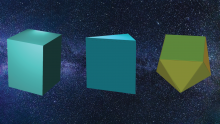
|
Closed Captioned Video: Geometry Applications--What Are Prisms? | Closed Captioned Video: Geometry Applications--What Are Prisms?
In this video students learn the basics of prisms and anti prisms. They learn the properties of triangular prisms, rectangular prisms, triangular antiprisms, and rectangular antiprisms. |
Rectangular Prisms and Triangular Prisms |
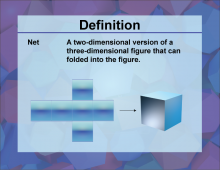
|
Definition--3D Geometry Concepts--Net | Net of a 3D FigureTopic3D Geometry DefinitionA net is a two-dimensional shape that can be folded to form a three-dimensional figure. DescriptionIn the realm of three-dimensional geometry, a net is an essential concept that helps in visualizing and constructing 3D shapes. A net is essentially a two-dimensional pattern that, when folded along specific lines, forms a three-dimensional object. This concept is particularly useful in understanding the properties and structures of 3D figures such as cubes, pyramids, and prisms. |
3-Dimensional Figures |
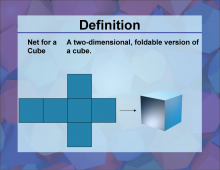
|
Definition--3D Geometry Concepts--Net for a Cube | Net for a CubeTopic3D Geometry DefinitionA net for a cube is a two-dimensional shape that can be folded to form a three-dimensional cube. DescriptionIn the realm of three-dimensional geometry, a net for a cube is a crucial concept. It represents a flattened out three-dimensional shape that can be folded along the edges to form a cube. This is an essential tool for visualizing and understanding how 3D shapes are constructed from 2D representations. |
Cubes |
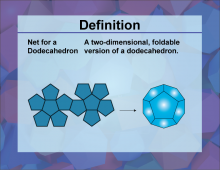
|
Definition--3D Geometry Concepts--Net for a Dodecahedron | Net for a DodecahedronTopic3D Geometry. DefinitionA net for a dodecahedron is a two-dimensional figure that can be folded to form a three-dimensional dodecahedron. DescriptionThe dodecahedron is one of the five Platonic solids, characterized by its twelve regular pentagonal faces, thirty edges, and twenty vertices. Understanding the net of a dodecahedron helps in visualizing and constructing this complex polyhedron from a flat sheet. |
3-Dimensional Figures |
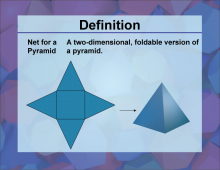
|
Definition--3D Geometry Concepts--Net for a Pyramid | Net for a PyramidTopic3D Geometry DefinitionA net for a pyramid is a two-dimensional representation that, when folded along its edges, forms the three-dimensional shape of a pyramid. DescriptionIn the study of three-dimensional geometry, understanding the concept of nets is crucial, particularly for complex shapes like pyramids. A net for a pyramid is essentially a flattened version of the 3D shape, showing all its faces in a single plane. This representation is invaluable for visualizing how the pyramid's surfaces connect and for calculating its surface area. |
Pyramids |
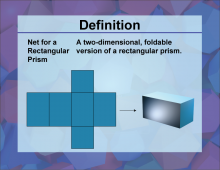
|
Definition--3D Geometry Concepts--Net for a Rectangular Prism | Net for a Rectangular PrismTopic3D Geometry DefinitionA net for a rectangular prism is a two-dimensional representation that, when folded, forms a three-dimensional rectangular prism. DescriptionIn the realm of three-dimensional geometry, the concept of a net is crucial for understanding how 3D shapes are constructed from 2D figures. A net for a rectangular prism is essentially a layout of all the faces of the prism in a single plane. This layout includes six rectangles that correspond to the six faces of the prism. By folding along the edges of these rectangles, one can recreate the three-dimensional shape of the rectangular prism. |
Rectangular Prisms |

|
Definition--3D Geometry Concepts--Net for a Tetrahedron | Net for a TetrahedronTopic3D Geometry DefinitionA net for a tetrahedron is a two-dimensional pattern that can be folded to form a three-dimensional tetrahedron, which is a polyhedron with four triangular faces. DescriptionIn the realm of three-dimensional geometry, the concept of a net is crucial for understanding the structure and properties of polyhedra. A tetrahedron, one of the simplest forms of polyhedra, consists of four triangular faces, six edges, and four vertices. The net of a tetrahedron is a flat, two-dimensional figure that, when folded along its edges, forms the three-dimensional shape of the tetrahedron. |
3-Dimensional Figures |
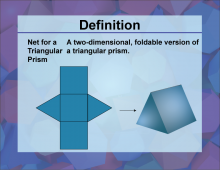
|
Definition--3D Geometry Concepts--Net for a Triangular Prism | Net for a Triangular PrismTopic3D Geometry DefinitionA net for a triangular prism is a two-dimensional figure that can be folded to form the surface of a three-dimensional triangular prism. DescriptionIn the context of three-dimensional geometry, a net is a crucial concept for understanding the surface area and structure of 3D shapes. Specifically, the net for a triangular prism consists of two triangular faces and three rectangular faces. When these faces are arranged in a specific two-dimensional pattern, they can be folded along the edges to form a triangular prism. |
Triangular Prisms |
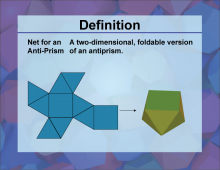
|
Definition--3D Geometry Concepts--Net for an Antiprism | Net for an AntiprismTopic3D Geometry. DefinitionA net for an antiprism is a two-dimensional shape that can be folded to form a three-dimensional antiprism, which is a type of polyhedron with two parallel polygonal bases connected by an alternating band of triangles. DescriptionIn the realm of three-dimensional geometry, an antiprism is a fascinating polyhedron that extends the concept of prisms. Unlike regular prisms, which have two parallel bases connected by rectangular faces, antiprisms have two parallel bases connected by an alternating band of triangles. This unique structure results in a more complex and often more visually interesting shape. |
3-Dimensional Figures |
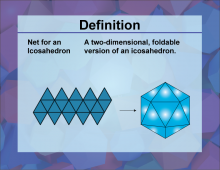
|
Definition--3D Geometry Concepts--Net for an Icosahedron | Net for an IcosahedronTopic3D Geometry DefinitionA net for an icosahedron is a two-dimensional flat pattern that, when folded along its edges, forms the surface of a three-dimensional icosahedron. DescriptionThe net for an icosahedron is a crucial concept in three-dimensional geometry, particularly in the study of polyhedra. An icosahedron is a regular polyhedron with 20 faces, each of which is an equilateral triangle. The net provides a visual representation of how these 20 triangular faces are connected and arranged in a flat pattern that can be folded to create the three-dimensional shape. |
3-Dimensional Figures |
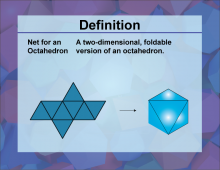
|
Definition--3D Geometry Concepts--Net for an Octahedron | Net for an OctahedronTopic3D Geometry DefinitionA net for an octahedron is a two-dimensional figure that can be folded to form a three-dimensional octahedron. DescriptionIn the realm of three-dimensional geometry, a net is a crucial concept that helps in visualizing and constructing 3D shapes from 2D representations. Specifically, a net for an octahedron consists of eight equilateral triangles arranged in a specific pattern. When these triangles are folded along the edges, they form an octahedron, which is a polyhedron with eight faces, twelve edges, and six vertices. |
3-Dimensional Figures |
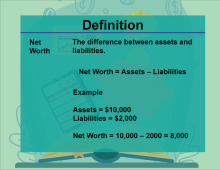
|
Definition--Financial Literacy--Net Worth | Net WorthTopicFinancial Literacy DefinitionNet worth is the total assets minus total liabilities of an individual or organization, representing financial health. |
Numerical and Algebraic Expressions |
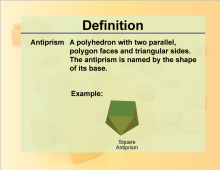
|
Definition--Geometry Basics--Antiprism | AntiprismTopicGeometry Basics DefinitionA polyhedron with two parallel faces and other faces that are triangular. DescriptionAn antiprism is a type of polyhedron that has two parallel faces connected by an alternating band of triangles. This geometric shape is significant in advanced geometry and has applications in fields such as crystallography and molecular chemistry. Understanding antiprisms helps in comprehending the properties of polyhedra and their role in three-dimensional space. For example, the volume of an antiprism can be calculated using specific geometric formulas, making it a useful concept in various scientific and mathematical applications. |
3-Dimensional Figures |
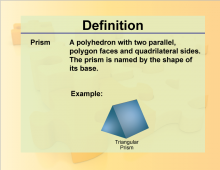
|
Definition--Geometry Basics--Prism | PrismTopicGeometry Basics DefinitionA prism is a solid shape with two parallel, congruent bases connected by rectangular or parallelogram faces. DescriptionPrisms are significant in the study of three-dimensional shapes. They have a uniform cross-section, allowing for easy calculations of volume and surface area. The volume can be calculated with the formula V = B⋅h where B is the area of the base and h is the height. Prisms are commonly encountered in real-world applications such as packaging and structural designs, making them an essential concept in geometry. |
3-Dimensional Figures |
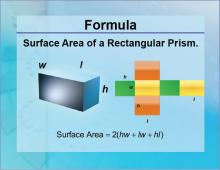
|
Formulas--Surface Area of a Rectangular Prism | Formulas--Surface Area of a Rectangular Prism
The formula for the Surface Area of a Rectangular Prism. This is part of a collection of math formulas. To see the complete collection of formulas, click on this link. Note: The download is a JPG file.Related ResourcesTo see resources related to this topic click on the Related Resources tab above. |
Surface Area |

|
Google Earth Voyager Story: Architectural Prisms, Part 1 | Google Earth Voyager Story: Architectural Prisms, Part 1TopicGeometric Models |
Triangular Prisms |

|
Google Earth Voyager Story: Architectural Prisms, Part 2 | Google Earth Voyager Story: Architectural Prisms, Part 2TopicGeometric Models |
Rectangular Prisms |

|
Google Earth Voyager Story: Architectural Prisms, Part 3 | Google Earth Voyager Story: Architectural Prisms, Part 3
In this Google Earth Voyager story visit architectural landmarks in New York City to learn about the geometry of prisms. In this lesson, visit the Freedom Tower in Lower Manhattan and learn about antiprisms. Then build a scale model of the Freedom Tower. This is part of a collection of Google Earth Voyager Stories that use Google's mapping technology to explore relevant math stories. To see the complete collection of the Google Earth Voyager Stories, click on this link. Note: The download is the teacher's guide.Viewing Media4Math Stories on Google EarthThese Google Earth Voyager Stories are also available on Google Earth. Best viewed in Chrome, click on the links below to view these dynamic stories using Google's technology: |
3-Dimensional Figures |
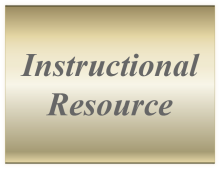
|
Instructional Resource--Calculating Net Worth | Instructional Resource | Calculating Net Worth
This tutorial goes over the definition of net worth and how to calculate it. —PRESS PREVIEW TO VIEW THE ACTIVITY— To see the complete collection of Instructional Resources, click on this link.Note: The download is a PDF file. Related ResourcesTo see resources related to this topic click on the Related Resources tab above. |
Numerical Expressions |

|
Lesson Plan: Nets of 3D Figures, Part 1 | Lesson Plan: Introduction to Nets and Basic 3D Shapes In this engaging and interactive lesson, students explore the connection between 2D nets and 3D geometric figures. Through animations, printable foldable nets, and hands-on activities, students will develop a deeper understanding of how nets transform into solid figures such as cubes, rectangular prisms, and triangular prisms. This lesson also reinforces key geometry concepts, including faces, edges, and vertices, while guiding students through surface area calculations using nets. |
3-Dimensional Figures |

|
Lesson Plan: Nets of 3D Figures, Part 2 | Lesson Plan: Pyramids, Tetrahedra, and Octahedra In this engaging lesson, students explore the geometry of pyramids, tetrahedra, and octahedra using 2D nets and 3D models. Through interactive animations, printable foldable nets, and hands-on activities, students develop a deeper understanding of how pyramids differ from prisms and why their triangular faces provide structural stability. This lesson covers key geometry concepts, including faces, edges, vertices, and surface area calculations. |
3-Dimensional Figures |

|
Lesson Plan: Nets of 3D Figures, Part 3 | Lesson Plan: Advanced Polyhedra and Cylindrical Shapes In this interactive lesson, students explore the geometry of cylinders and advanced polyhedra, including the dodecahedron and icosahedron. Using 2D nets and 3D models, students will construct these shapes, analyze their faces, edges, and vertices, and compare their properties to simpler geometric figures. This lesson emphasizes the differences between curved-surface shapes, like cylinders, and flat-faced polyhedra. |
3-Dimensional Figures |

|
Lesson Plan: Nets of 3D Figures, Part 4 | Lesson Plan: Extensions and Real-World Applications of Nets and 3D Shapes This engaging lesson explores advanced applications of 3D nets and their real-world connections in engineering, architecture, and packaging design. Students will investigate Euler’s Formula to understand the relationships between vertices, edges, and faces of polyhedra. They will also examine how geometric transformations (reflections, rotations) affect nets and learn how optimizing net design minimizes material waste. |
3-Dimensional Figures |
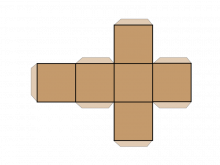
|
Math Clip Art--Net for a Cube | Math Clip Art--Net for a CubeTopicGeometry DescriptionThis math clip art image is part of a series showcasing 2D nets of 3D figures, specifically focusing on the net for a cube. The image displays a flattened representation of a cube, consisting of six connected squares arranged in a cross-like pattern. This visual aid is crucial for students to understand the relationship between 2D shapes and their 3D counterparts. |
3-Dimensional Figures |
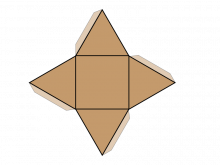
|
Math Clip Art--Net for a Pyramid | Math Clip Art--Net for a PyramidTopicGeometry DescriptionThis math clip art image is part of a series illustrating 2D nets of 3D figures, with this particular image focusing on the net for a pyramid. The image shows a flattened representation of a square-based pyramid, consisting of a square base surrounded by four triangular faces. This visual aid is essential for students to comprehend how a 3D pyramid can be unfolded into a 2D pattern. |
3-Dimensional Figures |
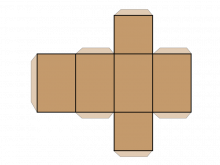
|
Math Clip Art--Net for a Rectangular Prism | Math Clip Art--Net for a Rectangular PrismTopicGeometry DescriptionThis math clip art image is part of a series showcasing 2D nets of 3D figures, specifically illustrating the net for a rectangular prism. The image displays a flattened representation of a rectangular prism, consisting of six connected rectangles arranged in a cross-like pattern. This visual aid is crucial for students to understand how a 3D rectangular prism can be unfolded into a 2D shape. |
3-Dimensional Figures |
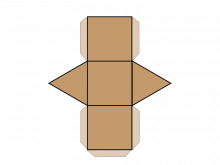
|
Math Clip Art--Net for a Triangular Prism | Math Clip Art--Net for a Triangular PrismTopicGeometry DescriptionThis math clip art image is part of a series illustrating 2D nets of 3D figures, with this particular image focusing on the net for a triangular prism. The image shows a flattened representation of a triangular prism, consisting of two triangular bases and three rectangular faces. This visual aid is essential for students to comprehend how a 3D triangular prism can be unfolded into a 2D pattern. |
3-Dimensional Figures |

|
Math Clip Art--Net for an Antiprism | Math Clip Art--Net for an AntiprismTopicGeometry DescriptionThis math clip art image is part of a series showcasing 2D nets of 3D figures, specifically illustrating the net for an antiprism. The image displays a flattened representation of an antiprism, consisting of two polygonal bases (typically regular polygons) connected by a band of triangles. This visual aid is crucial for students to understand how a 3D antiprism can be unfolded into a 2D shape. |
3-Dimensional Figures |

|
Math in the News: Issue 40--Will Netflix Bounce Back? | Math in the News: Issue 40--Will Netflix Bounce Back?
12/19/11. In this issue we look at the steep drop in the price of NetFlix’s stock. We examine why it happened and make a prediction about the stock’s future. This is part of the Math in the News collection. To see the complete collection, click on this link. Note: The download is a PPT file.Related ResourcesTo see resources related to this topic click on the Related Resources tab above. |
Data Analysis |
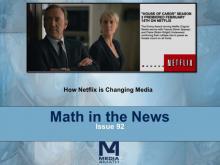
|
Math in the News: Issue 92--How Netflix Is Changing Media | Math in the News: Issue 92--How Netflix Is Changing Media
February 2014. In this issue of Math in the News we look at the dramatic growth in subscribers for Netflix. We calculate the rate of growth. We also explore how companies like Netflix are changing the viewing habits of all Americans. This is part of the Math in the News collection. To see the complete collection, click on this link. Note: The download is a PPT file.Related ResourcesTo see resources related to this topic click on the Related Resources tab above. |
Applications of Exponential and Logarithmic Functions |
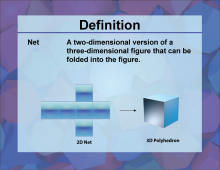
|
Video Definition 24--3D Geometry--Net | NetTopic3D Geometry DefinitionA net is a two-dimensional representation of a three-dimensional shape, showing all its faces laid out flat. |
3-Dimensional Figures |

|
Video Definition 24--3D Geometry--Net--Spanish Audio | Video Definition 24--3D Geometry--Net--Spanish Audio This is part of a collection of math video definitions related to the topic of 3D Geometry. These videos have Spanish audio. Note: The download is an MP4 video. |
3-Dimensional Figures |

|
Video Definition 25--3D Geometry--Net for a Cone | Net for a ConeTopic3D Geometry DefinitionA net for a cone is a two-dimensional representation of a cone, showing its circular base and curved surface laid out flat. |
3-Dimensional Figures |

|
Video Definition 25--3D Geometry--Net for a Cone--Spanish Audio | Video Definition 25--3D Geometry--Net for a Cone--Spanish Audio This is part of a collection of math video definitions related to the topic of 3D Geometry. These videos have Spanish audio. Note: The download is an MP4 video. |
3-Dimensional Figures |